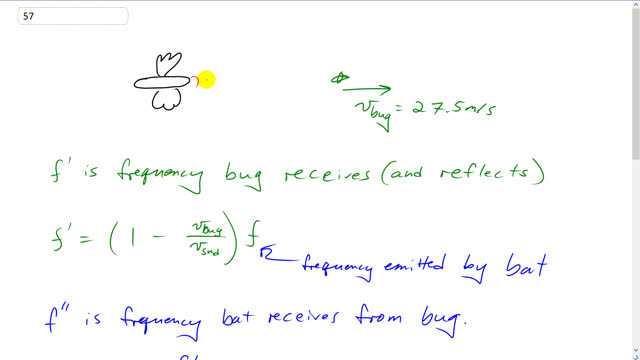
A bat at rest sends out ultrasonic sound waves at 50.0 kHz and receives them returned from an object moving directly away from it at 27.5 m/s. What is the received sound frequency?

In order to watch this solution you need to have a subscription.
This is Giancoli Answers with Mr. Dychko. This question is a little bit complicated because you have to use this Doppler effect formulas twice. On the one hand, you have this bat emitting some frequency, we'll call that f. And that's not the frequency that the bug that the bat is chasing is going to perceive though because the bug's moving away from the bat. And so we're going to call the frequency of the bug perceives f prime. And this is also going to be the frequency that the bug then reflects back towards the bat. But the bats not going to perceive that reflected frequency, f prime, because this is now thought of as a sound source which is moving away. And so the bats going to perceive a different frequency we'll call f double prime. So, on the one hand we're going to think of this is going to be the bat being stationary, and this being an observer moving away 27.5 meters per second and we'll use this formula then, moving observer away from the sound source. And then on the other hand, we'll think of this as being a sound source moving away from a stationary observer. That's the scenario here. Because the bug is reflecting this f prime but moving away. And so it's a moving sound source. And so we use this formula to get f double prime the frequency detected by the bat reflected from the bug. So, f prime is 1 minus speed of the bug divided by speed of sound times f, the frequency originally emitted by the bat. And then and that's also the frequency reflected by the bug. And then the frequency received by the bat is going to be f prime divided by, this is the frequency emitted by the bug or reflected in other words. And divided by 1 plus speed of the bug divided by speed of sound. So, this is the formula where the sound source is moving away from a stationary observer. And f prime though is 1 minus v bug over v sound times f, the frequency originally emitted by the bat. And so we plug that in for f prime. And it's plug and chug with the numbers. So, it's 1 minus 27.5 meters per second divided by 343 meters per second, all divided by 1 plus 27.5 over 343 times 50 times 10 to the 3 hertz, which gives about 42.6 kilohertz is going to be the frequency detected by the bat.